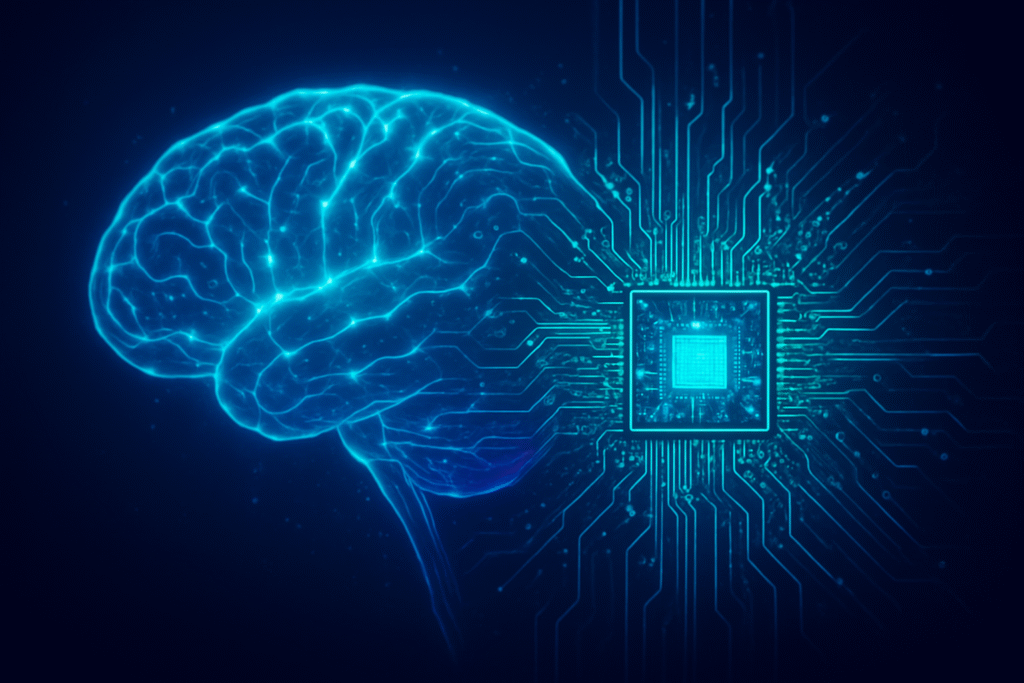
Neuromorphic computing represents a radical departure from traditional computer architectures, mimicking the human brain's intricate structure and function to create more efficient and powerful processing systems. Unlike conventional Von Neumann machines that separate processing and memory, neuromorphic chips integrate these functions directly within "artificial neurons" and "synapses." This brain-like design leverages spiking neural networks (SNNs), where computations occur in an event-driven, parallel manner, consuming energy only when neurons "spike" in response to signals, much like biological brains. This fundamental shift allows neuromorphic systems to excel in adaptability, real-time learning, and the simultaneous processing of multiple tasks.
The immediate significance of neuromorphic computing for advanced AI chips is transformative, addressing critical bottlenecks in current AI processing capabilities. Modern AI, particularly large language models and real-time sensory data processing, demands immense computational power and energy, often pushing traditional GPUs to their limits. Neuromorphic chips offer a compelling solution by delivering unparalleled energy efficiency, often consuming orders of magnitude less power for certain AI inference tasks. This efficiency, coupled with their inherent ability for real-time, low-latency decision-making, makes them ideal for crucial AI applications such as autonomous vehicles, robotics, cybersecurity, and advanced edge AI devices where continuous, intelligent processing with minimal power draw is essential. By fundamentally redesigning how AI hardware learns and processes information, neuromorphic computing is poised to accelerate AI development and enable a new generation of intelligent, responsive, and sustainable AI systems.
The Architecture of Intelligence: Diving Deep into Neuromorphic and Traditional AI Chips
Neuromorphic computing and advanced AI chips represent significant shifts in computational architecture, aiming to overcome the limitations of traditional von Neumann designs, particularly for artificial intelligence workloads. These innovations draw inspiration from the human brain's structure and function to deliver enhanced efficiency, adaptability, and processing capabilities.
Neuromorphic computing, also known as neuromorphic engineering, is an approach to computing that mimics the way the human brain works, designing both hardware and software to simulate neural and synaptic structures and functions. This paradigm uses artificial neurons to perform computations, prioritizing robustness, adaptability, and learning by emulating the brain's distributed processing across small computing elements. Key technical principles include Spiking Neural Networks (SNNs) for event-driven, asynchronous processing, collocated memory and processing to eliminate the von Neumann bottleneck, massive parallelism, and exceptional energy efficiency, often consuming orders of magnitude less power. Many neuromorphic processors also support on-chip learning, allowing them to adapt in real-time.
Leading the charge in neuromorphic hardware development are several key players. IBM (NYSE: IBM) has been a pioneer with its TrueNorth chip (released in 2015), featuring 1 million programmable spiking neurons and 256 million programmable synapses, consuming a mere 70 milliwatts. Its more recent "NorthPole" chip (2023), built on a 12nm process with 22 billion transistors, boasts 25 times more energy efficiency and is 22 times faster than NVIDIA's (NASDAQ: NVDA) V100 GPU for specific inference tasks. Intel (NASDAQ: INTC) has made significant strides with its Loihi research chips. Loihi 1 (2018) included 128 neuromorphic cores and up to 130,000 synthetic neurons. Loihi 2 (2021), fabricated on Intel's 4 process (7nm EUV), scaled up to 1 million neurons per chip and 120 million synapses, offering 10x faster spike processing. Intel's latest, Hala Point (2024), is a large-scale system with 1.15 billion neurons, demonstrating capabilities 50 times faster and 100 times more energy-efficient than conventional CPU/GPU systems for certain AI workloads. The University of Manchester's SpiNNaker project also contributes significantly with its highly parallel, event-driven architecture.
In contrast, traditional AI chips, like Graphics Processing Units (GPUs), Tensor Processing Units (TPUs), and Application-Specific Integrated Circuits (ASICs), accelerate AI by performing complex mathematical computations and massively parallel processing. NVIDIA's (NASDAQ: NVDA) H100 Tensor Core GPU, based on the Hopper architecture, delivers up to 9x the performance of its predecessor for AI processing, featuring specialized Tensor Cores and a Transformer Engine. Its successor, the Blackwell architecture, aims for up to 25 times better energy efficiency for training trillion-parameter models, boasting over 208 billion transistors. Google's custom-developed TPUs (e.g., TPU v5) are ASICs specifically optimized for machine learning workloads, offering fast matrix multiplication and inference. Other ASICs like Graphcore's Colossus MK2 (IPU-M2000) also provide immense computing power. Neural Processing Units (NPUs) found in consumer devices, such as Apple's (NASDAQ: AAPL) M2 Ultra (16-core Neural Engine, 22 trillion operations per second) and Qualcomm's (NASDAQ: QCOM) Snapdragon platforms, focus on efficient, real-time on-device inference for tasks like image recognition and natural language processing.
The fundamental difference lies in their architectural inspiration and operational paradigm. Traditional AI chips adhere to the von Neumann architecture, separating processing and memory, leading to the "von Neumann bottleneck." They use synchronous, clock-driven processing with continuous values, demanding substantial power. Neuromorphic chips, however, integrate memory and processing, employ asynchronous, event-driven spiking neural networks, and consume power only when neurons activate. This leads to drastically reduced power consumption and inherent support for real-time, continuous, and adaptive learning directly on the chip, making them more fault-tolerant and capable of responding to evolving stimuli without extensive retraining.
Initial reactions from the AI research community and industry experts have been overwhelmingly positive, citing neuromorphic computing as a "breakthrough year" for its transition from academic pursuit to tangible commercial products. Experts highlight energy efficiency, real-time processing, adaptability, enhanced pattern recognition, and the ability to overcome the von Neumann bottleneck as primary advantages. Many view it as a growth accelerator for AI, potentially boosting high-performance computing and even paving the way for Artificial General Intelligence (AGI). However, challenges remain, including potential accuracy concerns when converting deep neural networks to SNNs, a limited and underdeveloped software ecosystem, scalability issues, high processing latency in some real-world applications, and the significant investment required for research and development. The complexity and need for interdisciplinary expertise also present hurdles, alongside the challenge of competing with entrenched incumbents like NVIDIA (NASDAQ: NVDA) in the cloud and data center markets.
Shifting Sands: How Neuromorphic Computing Reshapes the AI Industry
Neuromorphic computing is poised to significantly impact AI companies, tech giants, and startups by offering unparalleled energy efficiency, real-time processing, and adaptive learning capabilities. This paradigm shift, leveraging brain-inspired hardware and spiking neural networks, is creating a dynamic competitive landscape.
AI companies focused purely on AI development stand to benefit immensely from neuromorphic computing's ability to handle complex AI tasks with significantly reduced power consumption and lower latency. This enables the deployment of more sophisticated AI models, especially at the edge, providing real-time, context-aware decision-making for autonomous systems and robotics. These companies can leverage the technology to develop advanced applications in predictive analytics, personalized user experiences, and optimized workflows, leading to reduced operational costs.
Major technology companies are heavily invested, viewing neuromorphic computing as crucial for the future of AI. Intel (NASDAQ: INTC), with its Loihi research chips and the large-scale Hala Point system, aims to perform AI workloads significantly faster and with less energy than conventional CPU/GPU systems, targeting sustainable AI research. IBM (NYSE: IBM), through its TrueNorth and NorthPole chips, is advancing brain-inspired systems to process vast amounts of data with tablet-level power consumption. Qualcomm (NASDAQ: QCOM) has been working on its "Zeroth" platform (NPU) for mobile devices, focusing on embedded cognition and real-time learning. Other tech giants like Samsung (KRX: 005930), Sony (NYSE: SONY), AMD (NASDAQ: AMD), NXP Semiconductors (NASDAQ: NXPI), and Hewlett Packard Enterprise (NYSE: HPE) are also active, often integrating neuromorphic principles into their product lines to offer specialized hardware with significant performance-per-watt improvements.
Numerous startups are also emerging as key innovators, often focusing on niche applications and ultra-low-power edge AI solutions. BrainChip (ASX: BRN) is a leader in commercializing neuromorphic technology with its Akida processor, designed for low-power edge AI in automotive, healthcare, and cybersecurity. GrAI Matter Labs focuses on ultra-low latency, low-power AI processors for edge applications, while SynSense (formerly aiCTX) specializes in ultra-low-power vision and sensor fusion. Other notable startups include Innatera, Prophesee, Aspirare Semi, Vivum Computing, Blumind, and Neurobus, each contributing to specialized areas within the neuromorphic ecosystem.
Neuromorphic computing poses a significant potential disruption. While not replacing general-purpose computing entirely, these chips excel at specific AI workloads requiring real-time processing, low power, and continuous learning at the edge. This could reduce reliance on power-hungry CPUs and GPUs for these specialized tasks, particularly for inference. It could also revolutionize Edge AI and IoT, enabling a new generation of smart devices capable of complex local AI tasks without constant cloud connectivity, addressing privacy concerns and reducing bandwidth. The need for specialized software and algorithms, such as spiking neural networks (SNNs), will also disrupt existing AI software ecosystems, creating a demand for new development environments and expertise.
The neuromorphic computing market is an emerging field with substantial growth potential, projected to reach USD 1,325.2 million by 2030, growing at a CAGR of 89.7% from 2024. Currently, it is best suited for challenges where its unique advantages are critical, such as pattern recognition, sensory processing, and continuous learning in dynamic environments. It offers a more sustainable path for AI development by drastically reducing power consumption, aligning with growing ESG standards. Initially, neuromorphic systems will likely complement traditional computing in hybrid architectures, offloading latency-critical AI workloads. The market is driven by significant investments from governments and major tech companies, though challenges remain regarding production costs, accessibility, and the scarcity of specialized programming expertise.
Beyond the Bottleneck: Neuromorphic Computing's Broader Impact on AI and Society
Neuromorphic computing represents a distinct paradigm within the broader AI landscape, differing fundamentally from deep learning, which is primarily a software algorithm running on conventional hardware like GPUs. While both are inspired by the brain, neuromorphic computing builds neurons directly into the hardware, often using spiking neural networks (SNNs) that communicate via electrical pulses, similar to biological neurons. This contrasts with deep neural networks (DNNs) that typically use continuous, more structured processing.
The wider significance of neuromorphic computing stems primarily from its potential to overcome the limitations of conventional computing systems, particularly in terms of energy efficiency and real-time processing. By integrating processing and memory, mimicking the brain's highly parallel and event-driven nature, neuromorphic chips drastically reduce power consumption—potentially 1,000 times less for some functions—making them ideal for power-constrained applications. This fundamental design allows for low-latency, real-time computation and continuous learning from new data without constant retraining, crucial for handling unpredictable real-world scenarios. It effectively circumvents the "von Neumann bottleneck" and offers inherent robustness and fault tolerance.
Neuromorphic computing is not necessarily a replacement for current AI, but rather a complementary technology that can enhance AI capabilities, especially where energy efficiency and real-time, on-device learning are critical. It aligns perfectly with several key AI trends: the rise of Edge AI, where processing occurs close to the data source; the increasing demand for Sustainable AI due to the massive energy footprint of large-scale models; and the quest for solutions beyond Moore's Law as traditional computing approaches face physical limitations. Researchers are actively exploring hybrid systems that combine neuromorphic and conventional computing elements to leverage the strengths of both.
The impacts of neuromorphic computing are far-reaching. In robotics, it enables more adaptive and intelligent machines that learn from their environment. For autonomous vehicles, it provides real-time sensory data processing for split-second decision-making. In healthcare, applications range from enhanced diagnostics and real-time neuroprosthetics to seizure prediction systems. It will empower IoT and smart cities with local data analysis, reducing latency and bandwidth. In cybersecurity, neuromorphic chips could continuously learn from network traffic to detect evolving threats. Other sectors like manufacturing, energy, finance, and telecommunications also stand to benefit from optimized processes and enhanced analytics. Ultimately, the potential for cost-saving in AI training and deployment could democratize access to advanced computing.
Despite its promise, neuromorphic computing faces several challenges and potential concerns. The high cost of development and manufacturing, coupled with limited commercial adoption, restricts accessibility. There is a significant need for a new, underdeveloped software ecosystem tailored for asynchronous, event-driven systems, as well as a lack of standardized benchmarks. Scalability and latency issues, along with potential accuracy concerns when converting deep neural networks to spiking ones, remain hurdles. The interdisciplinary complexity of the field and the learning curve for developers also present challenges. Ethically, as machines become more brain-like and capable of autonomous decision-making, profound questions arise concerning accountability, privacy, and the potential for artificial consciousness, demanding careful regulation and oversight, particularly in areas like autonomous weapons and brain-machine interfaces.
Neuromorphic computing can be seen as a significant evolutionary step in AI history, distinguishing itself from previous milestones. While early AI (Perceptrons, Expert Systems) laid foundational work and deep learning (DNNs, Backpropagation) achieved immense success through software simulations on traditional hardware, neuromorphic computing represents a fundamental re-imagining of the hardware itself. It aims to replicate the physical and functional aspects of biological neurons and synapses directly in silicon, moving beyond the von Neumann architecture's memory wall. This shift towards a more "brain-like" way of learning and adapting, with the potential to handle uncertainty and learn through observation, marks a paradigm shift from previous milestones where semiconductors merely enabled AI; now, AI is co-created with its specialized hardware.
The Road Ahead: Navigating the Future of Neuromorphic AI
Neuromorphic computing, with its brain-inspired architecture, is poised to revolutionize artificial intelligence and various other fields. This nascent field is expected to see substantial developments in both the near and long term, impacting a wide range of applications while also grappling with significant challenges.
In the near term (within 1-5 years, extending to 2030), neuromorphic computing is expected to see widespread adoption in Edge AI and Internet of Things (IoT) devices. These chips will power smart home devices, drones, robots, and various sensors, enabling local, real-time data processing without constant reliance on cloud servers. This will lead to enhanced AI capabilities, allowing devices to handle the unpredictability of the real world by efficiently detecting events, recognizing patterns, and performing training with smaller datasets. Energy efficiency will be a critical driver, particularly in power-sensitive scenarios, with experts predicting the integration of neuromorphic chips into smartphones by 2025. Advancements in materials science, focusing on memristors and other non-volatile memory devices, are crucial for more brain-like behavior and efficient on-chip learning. The development of hybrid architectures combining neuromorphic chips with conventional CPUs and GPUs is also anticipated, leveraging the strengths of each for diverse computational needs.
Looking further ahead, the long-term vision for neuromorphic computing centers on achieving truly cognitive AI and Artificial General Intelligence (AGI). Neuromorphic systems are considered one of the most biologically plausible paths toward AGI, promising new paradigms of AI that are not only more efficient but also more explainable, robust, and generalizable. Researchers aim to build neuromorphic computers with neuron counts comparable to the human cerebral cortex, capable of operating orders of magnitude faster than biological brains while consuming significantly less power. This approach is expected to revolutionize AI by enabling algorithms to run predominantly at the edge and address the anticipated end of Moore's Law.
Neuromorphic computing's brain-inspired architecture offers a wide array of potential applications across numerous sectors. These include:
- Edge AI and IoT: Enabling intelligent processing on devices with limited power.
- Image and Video Recognition: Enhancing capabilities in surveillance, self-driving cars, and medical imaging.
- Robotics: Creating more adaptive and intelligent robots that learn from their environment.
- Healthcare and Medical Applications: Facilitating real-time disease diagnosis, personalized drug discovery, and intelligent prosthetics.
- Autonomous Vehicles: Providing real-time decision-making capabilities and efficient sensor data processing.
- Natural Language Processing (NLP) and Speech Processing: Improving the understanding and generation capacities of NLP models.
- Fraud Detection: Identifying unusual patterns in transaction data more efficiently.
- Neuroscience Research: Offering a powerful platform to simulate and study brain functions.
- Optimization and Resource Management: Leveraging parallel processing for complex systems like supply chains and energy grids.
- Cybersecurity: Detecting evolving and novel patterns of threats in real-time.
Despite its promising future, neuromorphic computing faces several significant hurdles. A major challenge is the lack of a model hierarchy and an underdeveloped software ecosystem, making scaling and universality difficult. Developing algorithms that accurately mimic intricate neural processes is complex, and current biologically inspired algorithms may not yet match the accuracy of deep learning's backpropagation. The field also requires deep interdisciplinary expertise, making talent acquisition challenging. Scalability and training issues, particularly in distributing vast amounts of memory among numerous processors and the need for individual training, remain significant. Current neuromorphic processors, like Intel's (NASDAQ: INTC) Loihi, still struggle with high processing latency in certain real-world applications. Limited commercial adoption and a lack of standardized benchmarks further hinder widespread integration.
Experts widely predict that neuromorphic computing will profoundly impact the future of AI, revolutionizing AI computing by enabling algorithms to run efficiently at the edge due to their smaller size and low power consumption, thereby reducing reliance on energy-intensive cloud computing. This paradigm shift is also seen as a crucial solution to address the anticipated end of Moore's Law. The market for neuromorphic computing is projected for substantial growth, with some estimates forecasting it to reach USD 54.05 billion by 2035. The future of AI is envisioned as a "marriage of physics and neuroscience," with AI itself playing a critical role in accelerating semiconductor innovation. The emergence of hybrid architectures, combining traditional CPU/GPU cores with neuromorphic processors, is a likely near-term development, leveraging the strengths of each technology. The ultimate long-term prediction includes the potential for neuromorphic computing to unlock the path toward Artificial General Intelligence by fostering more efficient learning, real-time adaptation, and robust information processing capabilities.
The Dawn of Brain-Inspired AI: A Comprehensive Look at Neuromorphic Computing's Ascendancy
Neuromorphic computing represents a groundbreaking paradigm shift in artificial intelligence, moving beyond conventional computing to mimic the unparalleled efficiency and adaptability of the human brain. This technology, characterized by its integration of processing and memory within artificial neurons and synapses, promises to unlock a new era of AI capabilities, particularly for energy-constrained and real-time applications.
The key takeaways from this exploration highlight neuromorphic computing's core strengths: its extreme energy efficiency, often reducing power consumption by orders of magnitude compared to traditional AI chips; its capacity for real-time processing and continuous adaptability through spiking neural networks (SNNs); and its ability to overcome the von Neumann bottleneck by co-locating memory and computation. Companies like IBM (NYSE: IBM) and Intel (NASDAQ: INTC) are leading the charge in hardware development, with chips like NorthPole and Hala Point demonstrating significant performance and efficiency gains. These advancements are critical for driving AI forward in areas like autonomous vehicles, robotics, edge AI, and cybersecurity.
In the annals of AI history, neuromorphic computing is not merely an incremental improvement but a fundamental re-imagining of the hardware itself. While earlier AI milestones focused on algorithmic breakthroughs and software running on traditional architectures, neuromorphic computing directly embeds brain-like functionality into silicon. This approach is seen as a "growth accelerator for AI" and a potential pathway to Artificial General Intelligence, addressing the escalating energy demands of modern AI and offering a sustainable solution beyond the limitations of Moore's Law. Its significance lies in enabling AI systems to learn, adapt, and operate with an efficiency and robustness closer to biological intelligence.
The long-term impact of neuromorphic computing is expected to be profound, transforming human interaction with intelligent machines and integrating brain-like capabilities into a vast array of devices. It promises a future where AI systems are not only more powerful but also significantly more energy-efficient, potentially matching the power consumption of the human brain. This will enable more robust AI models capable of operating effectively in dynamic, unpredictable real-world environments. The projected substantial growth of the neuromorphic computing market underscores its potential to become a cornerstone of future AI development, driving innovation in areas from advanced robotics to personalized healthcare.
In the coming weeks and months, several critical areas warrant close attention. Watch for continued advancements in chip design and materials, particularly the integration of novel memristive devices and hybrid architectures that further mimic biological synapses. Progress in software and algorithm development for neuromorphic systems is crucial, as is the push towards scaling and standardization to ensure broader adoption and interoperability. Keep an eye on increased collaborations and funding initiatives between academia, industry, and government, which will accelerate research and development. Finally, observe the emergence of new applications and proof points in fields like autonomous drones, real-time medical diagnostics, and enhanced cybersecurity, which will demonstrate the practical viability and growing impact of this transformative technology. Experiments combining neuromorphic computing with quantum computing and "brain-on-chip" innovations could also open entirely new frontiers.
This content is intended for informational purposes only and represents analysis of current AI developments.
TokenRing AI delivers enterprise-grade solutions for multi-agent AI workflow orchestration, AI-powered development tools, and seamless remote collaboration platforms.
For more information, visit https://www.tokenring.ai/.







